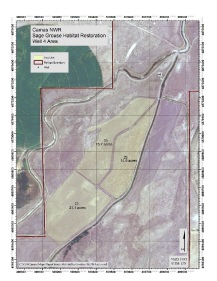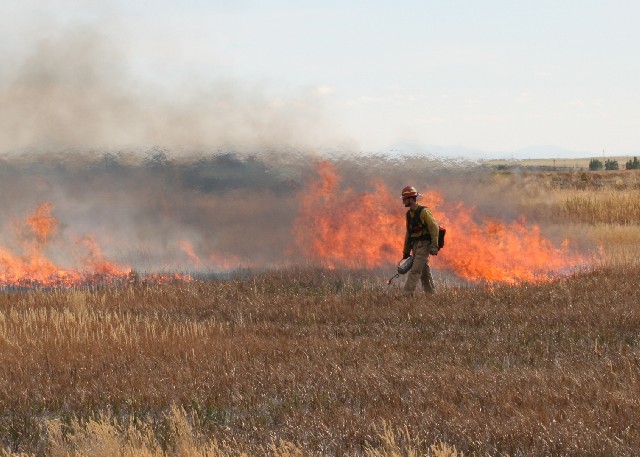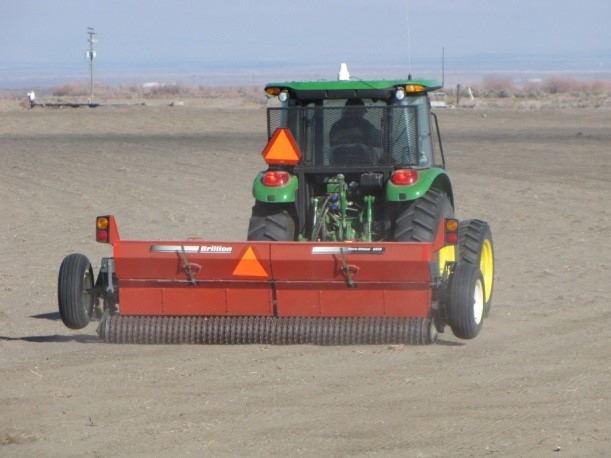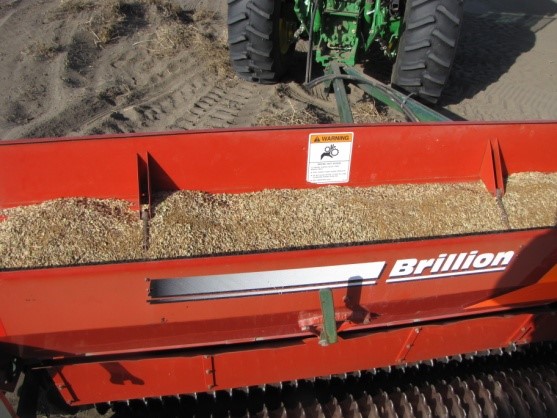 Kent L. Christopher Sagebrush Restoration Project at Camas NWR. Kent Christopher (August 4, 1953 - March 23, 2008) was an Educator, a Master Falconer, an organizer of the North American Grouse Partnership, and the founder of Dubois Grouse Days. He was a champion of sage grouse conservation in the open spaces of the Upper Snake River Plain, where the sky is wide and the hawks fly high.
Kent L. Christopher Sagebrush Restoration Project at Camas NWR. Kent Christopher (August 4, 1953 - March 23, 2008) was an Educator, a Master Falconer, an organizer of the North American Grouse Partnership, and the founder of Dubois Grouse Days. He was a champion of sage grouse conservation in the open spaces of the Upper Snake River Plain, where the sky is wide and the hawks fly high.
Kent Christopher Sagebrush Restoration Site
To assist with Trumpeter Swan recovery in the 1960s, sagebrush habitat was removed from portions of the Camas National Wildlife Refuge to farm small grain. Today, these fields are no longer needed for swans, but are needed for sage grouse, if restoration of the sagebrush ecosystem is possible. In addition, successful restoration would demonstrate that previously farmed areas can be restored to healthy sagebrush habitat. There were several partners for this project, including Dubois Grouse Days. Restoration took place over a three year period at the initial project site and included: a prescribed burn, herbicide application to remove non-native vegetation, native grass seeding, and finally, planting of sagebrush starts. Additional grain fields on the Refuge will be restored in the future.
With sage grouse populations in Idaho near an all time low at the turn of the 21st century, the goal of this project was to improve brood-rearing habitat for grouse nesting nearby. The effort begin in 2007, when funding and support was secured from the Rocky Mountain Foundation, the Upper Snake Sage Grouse Local Working Group, the Idaho Office of Species Conservation, North American Grouse Partnership, Dubois Grouse Days, Idaho Department of Fish and Game, and the US Fish and Wildlife Service.
 Phase I of on-the-ground rehabilitation began in 2008 on a 20-acre plot of formerly irrigated cropland. The project hopes to demonstrate the feasibility of returning abandoned agricultural land to premier sage grouse brood-rearing habitat.
Phase I of on-the-ground rehabilitation began in 2008 on a 20-acre plot of formerly irrigated cropland. The project hopes to demonstrate the feasibility of returning abandoned agricultural land to premier sage grouse brood-rearing habitat.
Through the acquisition of additional funding, CNWR staff was able to expand the original sagebrush restoration project to 90 acres. That was the good news. The bad news was that the sites had been overrun with smooth brome grass, which has proven much more difficult to remove than anticipated. For this reason, the acreage was deep-plowed, to ensure as much vegetative competition is removed from the site as possible, to give the native seed a chance to grow. Another hindrance has been the lack of rainfall in the past couple of years. However, with seedbed preparation and Mother Nature willing to help out with some rain, Camas staff is planning to seed about 10 acres this fall (2013). The plan is to seed in sections to take advantage of good planting conditions and protect against complete failure if winter and spring moisture is insufficient.
Kent Christopher's vision of saving native habitats lives on through this project. May his spirit forever soar like a hawk.

Reseeding native species at the Kent Christopher Restoration Project, November 2014.

Reseeding native species at the Kent Christopher Restoration Project, November 2014.
Update to Kent Christopher Upland Restoration Site as Camas NWR 2018
By Brian Wehausen, Refuge Manager
It was about 2007 when the staff of Camas NWR, set out to attempt to restore a previously farmed field on the Refuge back to native grasses and shrubs. It was a site that had occasional use by sage-grouse and the dominate vegetation was smooth brome and cheatgrass which are both non-native species and provide little habitat value. This site was named after the late Kent Christopher, a champion for not only sage-grouse, but also the sagebrush habitat these birds need to have in order to survive.
One of the stated goals for this project was to attempt to complete an upland restoration without the use of irrigation. This proved to be a challenge that we have not been able to successfully overcome. In our first attempt, tools such as fire, mechanical treatment (in this case discing), and herbicides were used in combination to attempt to remove the undesired vegetation and seed in native grasses and forbs. This first attempt failed as the smooth brome was not killed and quickly dominated the seeding that took place.
Our next attempted technique to remove the smooth brome from the site was to moldboard plow the site and turn the soil deep enough to bury the smooth brome roots and seeds. On the positive side, this technique was successful at removing smooth brome from the site. However, turning the sandy soils of this site caused us other challenges. The first seeding attempt after plowing failed, likely for two reasons. First, we seeded the site in the fall with the hope of good moisture during the winter months and some timely spring rainfall. We got neither, and really had no germination of seed. Also, with no vegetation or moisture to hold the sandy soil, the spring winds eroded it, exposing seeds and actually blowing many of them away.
Today, the site is a patch of various annual weeds. At this time, we are allowing these to be present to have soil stabilization. We are hoping that we can find a technique that will get our native seeds started. Once the native grasses and forbs establish, they should outcompete the annual weed and eventually take over the site. We are also implementing the use of irrigation and seeding in small patches that we can water. If we can be successful with this technique we will seed in small patches and irrigate until we have covered the entire 90-acre restoration site.